Argentina
Things to DO
Buenos Aires
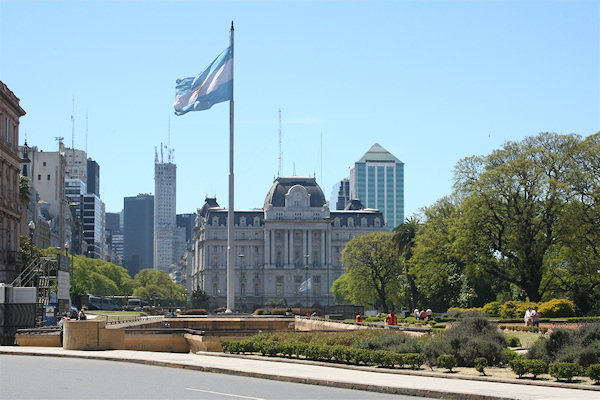 |
|||||
Buenos Aires is a huge city, but most places of interest to travelers are concentrated in just a few
easily accessible neighborhoods.
At the heart of the city is Microcenter, the downtown business center. Here you'll see endless
crowds of buisness suits and power skirts speaking into cell phones as they hasten about the narrow
streets in the shadows of skycrapers and old European buildings.
Here is also Plaza de Mayo, often filled with people resting on benches or taking photos of historic
buildings.
The newest and least conventional barrios is Puerto Madero. It's a wonderful place to stroll,
boasting cobbled stone paths and a long line of attractive brick warehouses that have been converted
into titzy new lofts, business offices and upscale restaurants.
In the Darsena the Fregata Sarmiento, wich sailed arround the world 40 times between1899 and 1938.
On board are records of its voyages and plenty of nautic items.
The Opera Bay, looking like a flattened Sydney Opera House, has a dramatic setting, with a back
deck and a pool that look over pretty Puerto Madero.
La Boca
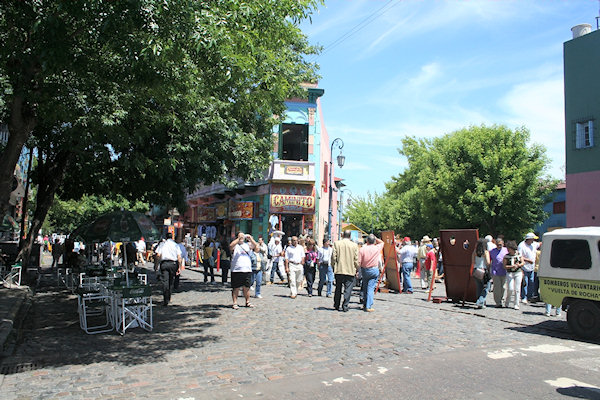 |
|||||
Blue collar and raffish to the core, La Boca is very much a locals' neighborhood. In the
mid-19th century, La Boca became home to Spanish and italian immigrants who settled along the Riachuelo,
the sinuous river that divides the city from the surrounding provence of Buenos Aires.
Caminito is the barrio's most famous street, and on weekends busloads of camera-laden tourists
come here for photographs and to browse the small weekend crafts fair while watching tango dancers
perform for spare change.
Four blocks inland is La Bombonera stadium, home of the Boca Juniors soccer team - the former club
of disgraced superstar Diego Maradona.
Recoleta
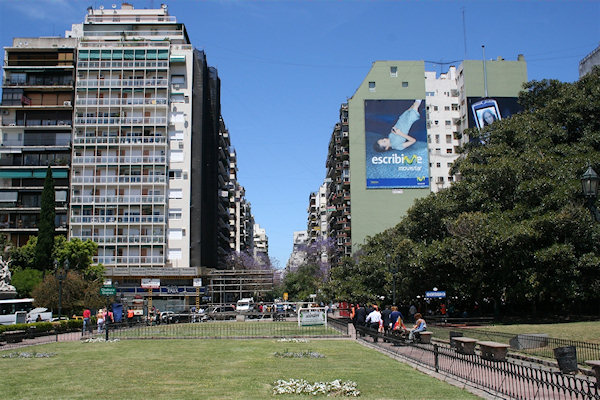 |
|||||
Buenos wealthiest citizens live and breath in Recoleta, the city's most exclusive and
fashionable neighborhood. The barrio's (=district), is full of lush parks, classy museums and
French architecture.
Iglesia de Nuestra Senora del Pilar; It is considered to be one of the most beautiful works of
Buenos Aires Colonial architecture. It is a second oldest temple in the city and of the few that keeps
all its imagery, ornaments and a series of historical pictures.
This church was inaugurated in 1732 and built by Jesuit architects Andrés Bianchi and Giovanni Battista
Primoli.
A little further north is the sinuous sculptural flower Floralis Genérica; it's one the most
recognizable images of Buenos Aires. The shiny flower consists of 6 petals (each measuring 13 meters
long and 7 meters wide) and 4 pistons. The petals close in the evening from sunset to sunup; a 20-minute
process mimicking the actual movement of a flower. It is surrounded by a peaceful pool and winding paths
allowing for different viewpoints and quiet contemplation.
Cementerio de la Recoleta
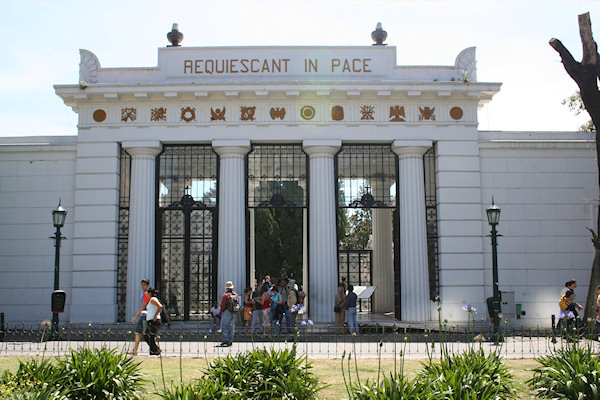 |
|||||
Cementerio de la Recoleta, with it's impressive statues and marble sarcophagi crypts hold
the remains of the city's most elite: past presidents, military heroes, influential politicians and the
just plain well-connected rich and famous.
The Cementerio de la Recoleta has over 4,700 ornate tombs and mausoleums spread over more than five
hectares. Many of these tombs have been created by important architects and are adorned with sculptures.
Over ninety of these have been declared a National Historic Monument.
Since 1946 the cemetery itself is considered a National Historic Museum because of the illustrious
personalities which are interred there, its architectural quality and the magnificence of its
sculptures.
The most internationally famous historical and political figure in the cemetery is Eva “Evita” Duarte
de Perón, wife of former Argentine President Juan Domingo Perón and a political leader in her own right.
Tango
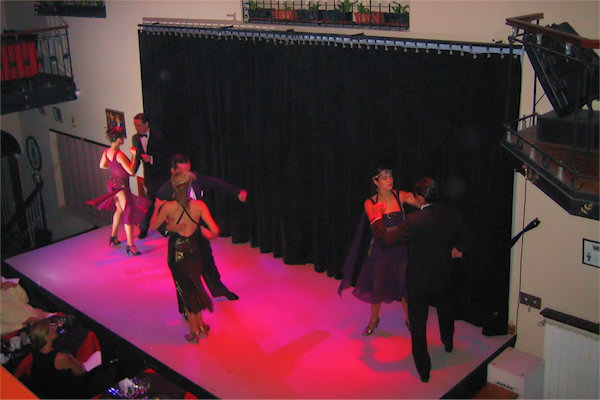 |
|||||
The history of Tango began in Buenos Aires, in the late 19th century. The dance started in the
lower-class districts of Buenos Aires taking place in the periphery of the city, bars, cafes and courtyards.
Then tango took the next step into more established Dancing Houses and later inside middle and high class
Argentinian homes.
Today, tango is experiencing a renaissance, both at the amateur and professional levels and among all ages.
Classes, milongas and shows are everywhere. Purists don't consider them authentic - though this doesn't make
theme necessarily bad.
Foz do Iguacu
Parque Nacional Iquazu
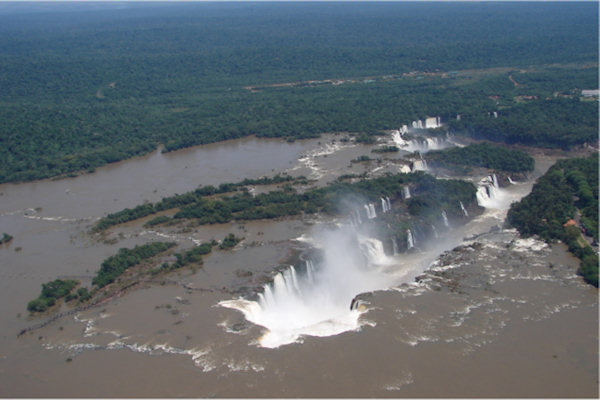 |
|||||
Iguazu National Park was created in 1934, and covers an area of approximately 67.620 hectares.
It was declared a UNESCO World Heritage Site in 1984 owing to its beatifull landscapes and large biodiversity
of the subtropical forest.
This natural sanctuary is located in the far NE of the Republic of Argentina. With large amounts of
precipitation, warm temperatures (15C on average in winter and 30C in summer) and the thick vegetation acting
as a windscreen, it experiences extremely high levels of humidity.
The Iguazu river flows for approximately 1.320 km until its outlet in the Parana. Its width generally varies
between 500 and 1.000 m however within the park it broadens to 1.500 meters and it twists to the south,
then back to the north, forming a huge U which contains the outlet.
A sudden drop in altitude here is the reason for the impressive water falls which form the main attraction
of the park. In this large curved path, the rocky landscape fragments the river into a multitude of channels,
each of these in turn become its own waterfall. This long fragmenting effect results in the fan of falls
which gives the park its name.
Flora & Fauna
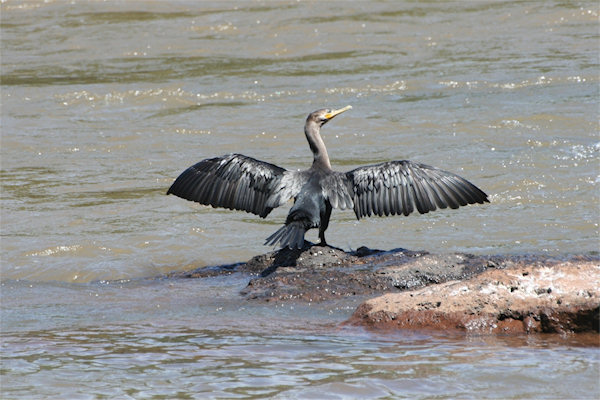 |
|||||
The large variety of species is one of the reasons that the flora and the fauna are, almost as much as
the waterfalls, some of the main attractions of the Park.
Along the journey you will be amazed watching the many, brightly-coloured birds, mammals, flowers and
lush forest vegetation.
On the catwalks, you can frequently see groups of coatis who have become very accustomed to humans. Please
do not feed them however as it is very unhealthy both mentally and physically for them.
On the trails you can see a huge variety of butterflies, a common species has exquisite yellow colouring
mixed with red and black. You can see them almost anywhere you can find a puddle, as they absorb the
dissolved salt in the water.
Towards noon on the sunny parts of the trails you should be able to watch Trodipurus lizards, which nimbly
climb tree trunks and stones to the catwalks and stairs.